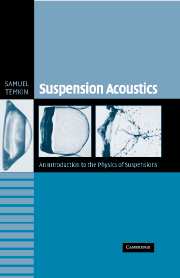Book contents
- Frontmatter
- Contents
- List of Figures and Tables
- Preface
- 1 Preliminaries
- 2 Conservation Equations
- 3 Rigid-Particle Heat Transfer at Re ≪ 1
- 4 Translational Motion at Re ≪ 1
- 5 Shape Deformations
- 6 Volume Pulsations
- 7 Thermodynamics of Suspensions
- 8 The Two-Phase Model
- 9 Sound Propagation in Suspensions
- 10 Applications and Extensions
- Appendix A Material and Transport Properties of Some Substances at 1 atm and 20°C
- Appendix B Useful Formulas from Vector Analysis
- Appendix C Explicit Expressions for Some Quantities in Spherical Polar Coordinates
- Appendix D Some Properties of the Spherical Bessel Functions
- Appendix E Legendre Polynomials
- Bibliography
- Author Index
- Subject Index
- Symbol Index
10 - Applications and Extensions
Published online by Cambridge University Press: 25 August 2009
- Frontmatter
- Contents
- List of Figures and Tables
- Preface
- 1 Preliminaries
- 2 Conservation Equations
- 3 Rigid-Particle Heat Transfer at Re ≪ 1
- 4 Translational Motion at Re ≪ 1
- 5 Shape Deformations
- 6 Volume Pulsations
- 7 Thermodynamics of Suspensions
- 8 The Two-Phase Model
- 9 Sound Propagation in Suspensions
- 10 Applications and Extensions
- Appendix A Material and Transport Properties of Some Substances at 1 atm and 20°C
- Appendix B Useful Formulas from Vector Analysis
- Appendix C Explicit Expressions for Some Quantities in Spherical Polar Coordinates
- Appendix D Some Properties of the Spherical Bessel Functions
- Appendix E Legendre Polynomials
- Bibliography
- Author Index
- Subject Index
- Symbol Index
Summary
Introduction
We conclude this work with a brief discussion of some topics that relate to the acoustic motions treated in Chapters 8 and 9. The topics selected are important examples of the use of acoustic waves – weak and strong – in suspension studies. The discussion is meant only to convey an idea about those applications, some of which are still being developed.
The examples that are addressed here relate to the use of acoustic theories to: (1) consider a simple acoustic problem; (2) measure particle sizes and concentrations in suspensions; and (3) to see the coalescence effects produced by sound waves. Some of these are important in those situations where a need arises to modify the sizes of the particles or to determine them. The number of techniques available to do the latter is rather limited, but optical scattering is perhaps the best known. However, optical beams are not capable to penetrate deeply into liquid media. The acoustic wave, on the other hand, can do that, and has therefore become another technique that can be used for that purpose.
The third example refers to the acoustic modification of particle size distributions in suspensions. In some applications – e.g., in trying to remove small particles from industrial fumes – it is desirable to increase that size, whereas in others the opposite effect is sought (e.g., in the production of finely dispersed droplets). Acoustic waves are capable of producing both effects, though strong waves are usually required.
- Type
- Chapter
- Information
- Suspension AcousticsAn Introduction to the Physics of Suspensions, pp. 318 - 358Publisher: Cambridge University PressPrint publication year: 2005



